Our verdict
- Top pick in best shoes for light hiking
Pros
- Grippy and durable lugs
- Extremely breathable
- Lighter than average
- Protective and bouncy midsole
- Great for long hikes
- Speedy and tenacious
- Comfortable and high-quality upper construction
- Secure lockdown
- No break-in required
- Performs consistently in the cold
Cons
- Not ideal for wide feet
- Tongue slippage
Audience verdict
- Top 15% in hiking shoes
- Top 20% in Salomon hiking shoes
Comparison
The most similar hiking shoes compared
+ + Add a shoe | |||||
|---|---|---|---|---|---|
| Audience score | 89 Great! | 88 Great! | 89 Great! | 89 Great! | |
| Price | $120 | $140 | $120 | $110 | |
| Trail terrain | ModerateTechnical | Moderate | Technical | Moderate | |
| Shock absorption | - | High | Low | - | |
| Energy return | - | Low | Moderate | - | |
| Weight lab Weight brand | 11.6 oz / 329g 11.5 oz / 326g | 11.6 oz / 329g 12.3 oz / 350g | 15.3 oz / 434g 16.2 oz / 460g | 12.7 oz / 361g 8.8 oz / 250g | |
| Lightweight | ✓ | ✓ | ✗ | ✓ | |
| Breathability | Breathable | Breathable | Breathable | Breathable | |
| Use | Day HikingSpeed HikingLight HikingBeginners | Day HikingSpeed HikingLight Hiking | Day HikingBeginners | Speed HikingLight HikingBeginners | |
| Orthotic friendly | ✓ | ✓ | ✓ | ✓ | |
| Drop lab | 10.2 mm | 15.0 mm | 11.2 mm | 9.6 mm | |
| Size | True to size | Half size small | True to size | Slightly small | |
| Midsole softness | Soft | Soft | Firm | Balanced | |
| Difference in midsole softness in cold | Small | Normal | Normal | Normal | |
| Torsional rigidity | Moderate | Stiff | Moderate | Stiff | |
| Heel counter stiffness | Flexible | Flexible | Flexible | Flexible | |
| Stiffness | Moderate | Moderate | Flexible | Moderate | |
| Outsole hardness | Average | Average | Average | Average | |
| Material | - | Mesh | LeatherMesh | - | |
| Season | SummerAll seasons | SummerAll seasons | SummerAll seasons | SummerAll seasons | |
| Toebox durability | Decent | Very good | - | Decent | |
| Heel padding durability | Good | Bad | - | Bad | |
| Outsole durability | Good | Good | - | Bad | |
| Width / fit | Medium | Medium | Medium | Medium | |
| Toebox width | Medium | Wide | Medium | Medium | |
| Lug depth | 4.1 mm | 3.7 mm | 4.8 mm | 3.4 mm | |
| Heel stack lab | 30.3 mm | 38.8 mm | 31.7 mm | 30.6 mm | |
| Forefoot | 20.1 mm | 23.8 mm | 20.5 mm | 21.0 mm | |
| Widths available | Normal | NormalWide | NormalWide | Normal | |
| Technology | Ortholite | - | Vibram | - | |
| Heel tab | Pull tab | Finger loop | Finger loop | Finger loop | |
| Removable insole | ✓ | ✓ | ✓ | ✓ | |
| Ranking | #5 Top 15% | #9 Top 26% | #7 Top 20% | #6 Top 18% | |
| Popularity | #26 Bottom 25% | #6 Top 18% | #1 Top 3% | #33 Bottom 5% |
Who should buy
We recommend the Salmon Outoulse as a great choice for hikers:
- In the market for a lightweight and nimble shoe to tackle the trails with speed
- Who face a variety of surfaces during their hikes
- In hot climates looking for a shoe that’s comfy and breathable
- Looking for a versatile shoe that can also tackle light trail runs
- In need of a durable and long-lasting shoe

Who should NOT buy
The Outpulse isn’t stable enough underfoot to support carrying a heavy pack for extended distances over uneven surfaces. For backpackers embarking on multi-day treks with lots of gear, we recommend the Merrel Moab 3 as a true beast of burden.
While the Outpulse performs extremely well in our freezer tests, we don’t recommend it for winter hikes in extremely cold climates as its well-ventilated nature will likely lead to frost-bitten toes. We recommend the Salomon X Ultra 4 GTX as a truly weatherproof alternative that can better tackle the tundra.
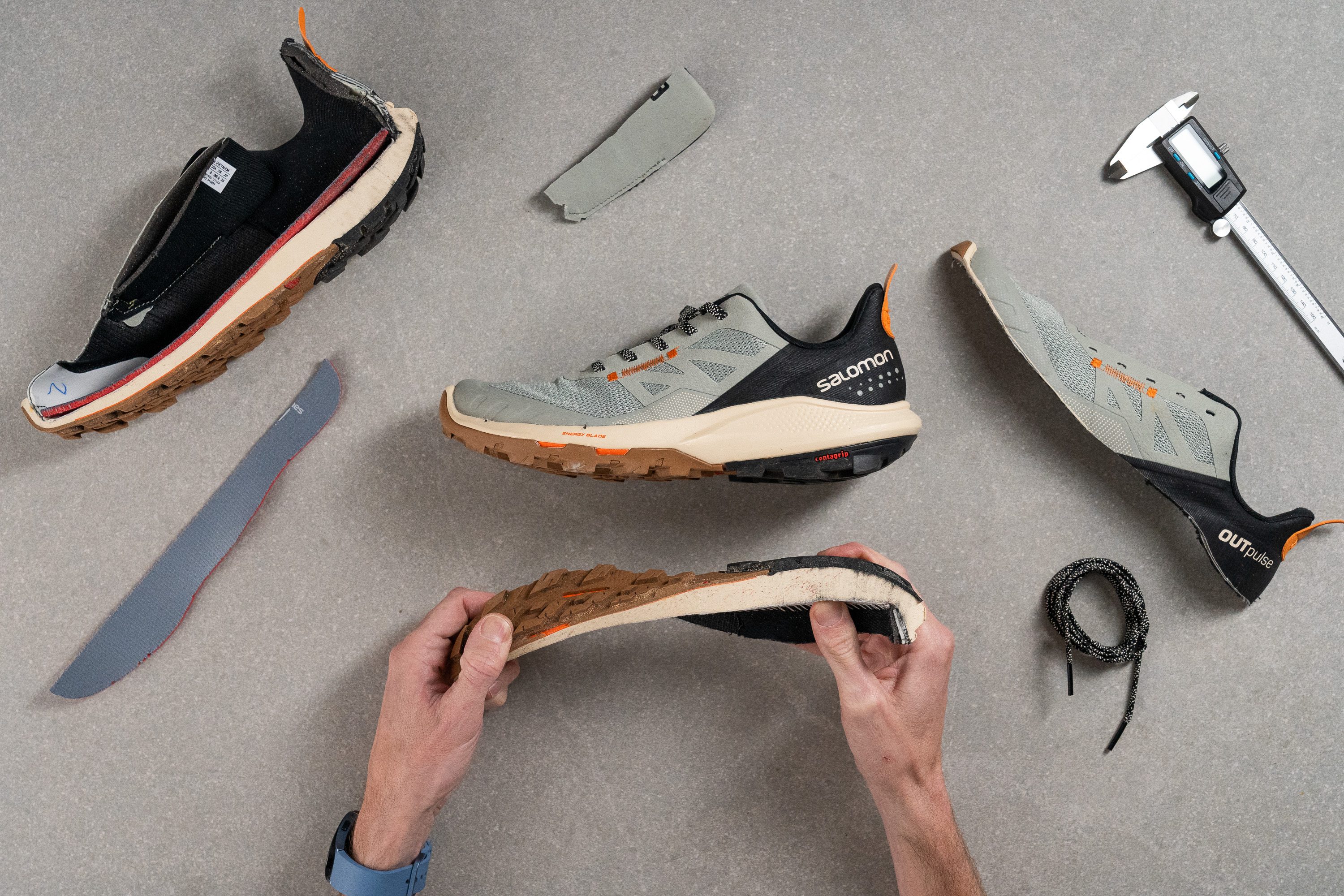
Cushioning
Heel stack
We measured the Outpulse’s stack to be 30.3 mm thick at the heel. While this is shorter than average, there’s still plenty of foam underfoot to provide well-cushioned landings no matter how harsh the surface below is.

| Outpulse | 30.3 mm |
| Average | 32.8 mm |
Forefoot stack
At 20.1 mm according to our caliper measurements, the Outpulse’s forefoot stack is just shy of our current lab average. This amount of foam underfoot provided us with a good balance of comfortable cushioning and ground feel that kept us going mile after mile during our test hikes.
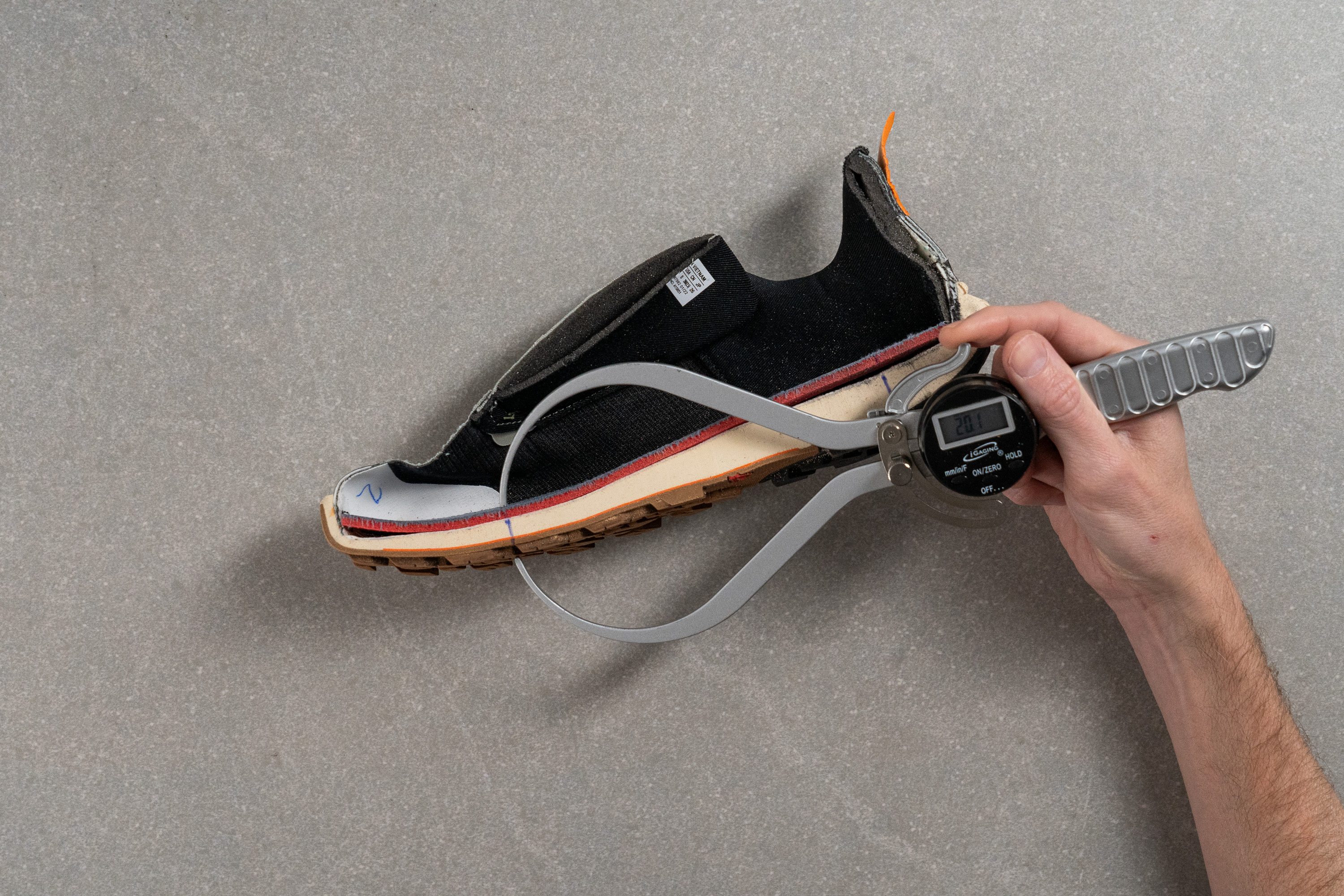
| Outpulse | 20.1 mm |
| Average | 22.0 mm |
Drop
The difference in our stack measurements leaves us with a drop height of 10.2 mm, classifying the Outpulse as a high-drop shoe. This is advantageous for those with calf or ankle issues or those prone to Achilles tendon injuries as it puts more stress on the knees and hips rather than the lower leg.
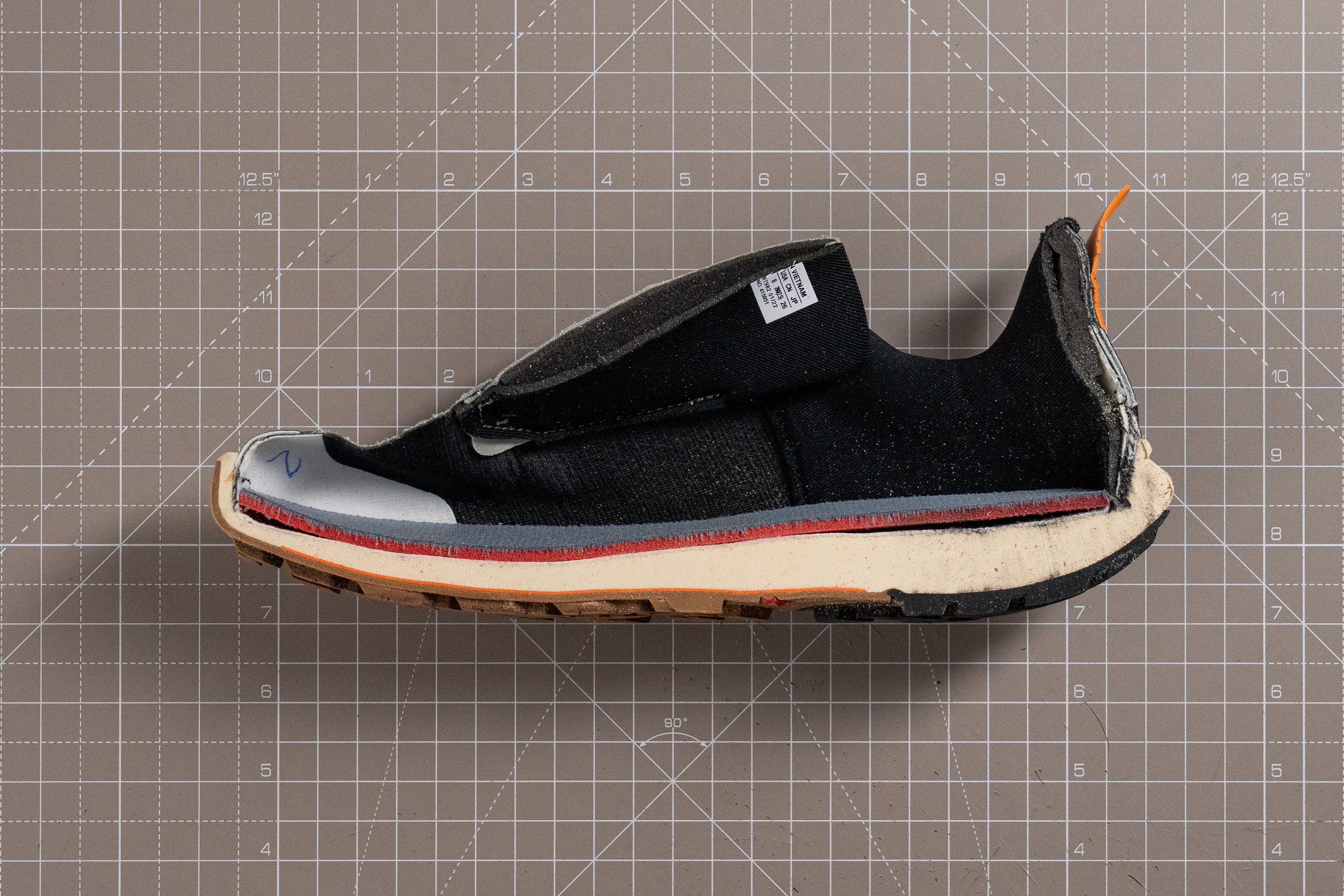
Conversely, those with sensitive knees or hips should consider a shoe with a less drastic offset like the Danner Trail 2650.
| Outpulse | 10.2 mm |
| Average | 10.7 mm |
Midsole softness
While hiking shoes tend to boast rather firm midsoles, the Outpulse falls more in line with the average road running shoe with a durometer reading of 22.6 HA.
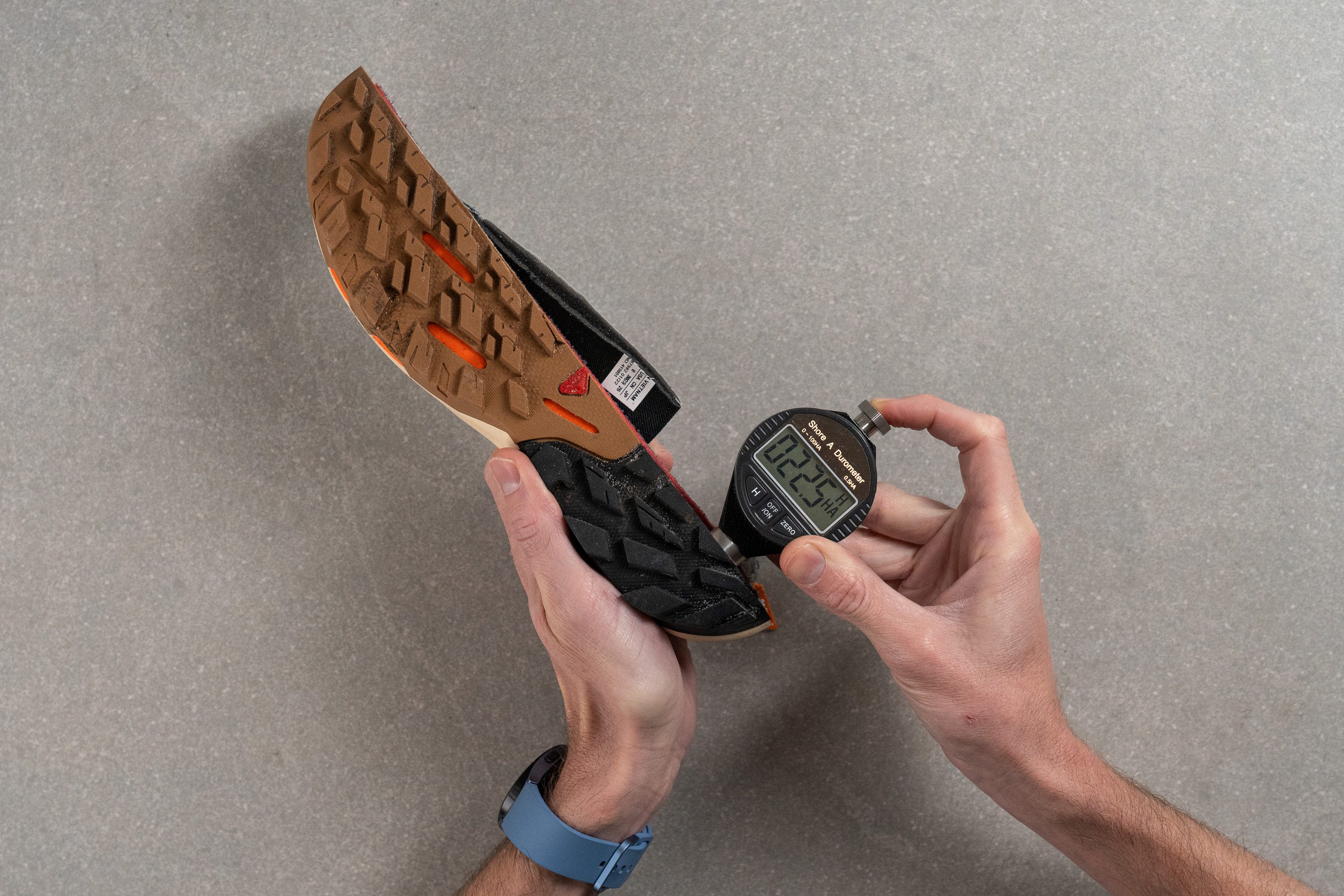
This level of softness allows the midsole to compress under our weight and provide excellent impact-dampening without feeling too squishy or unstable whether going uphill or down.
The midsole also returns to shape with a snappy rebound that feels responsive and can facilitate speedy walks or even light runs with ease.
| Outpulse | 22.6 HA |
| Average | 27.0 HA |
Size and fit
Size
Salomon Outpulse fits true to size (18 votes).
Width / Fit
Having retrieved a gel mold of the Outpulse, we used a digital caliper to measure its internal dimensions as precisely as possible.
With 93.4 mm in its widest part, this Salomon shoe falls right into the medium-width range of hiking shoes.
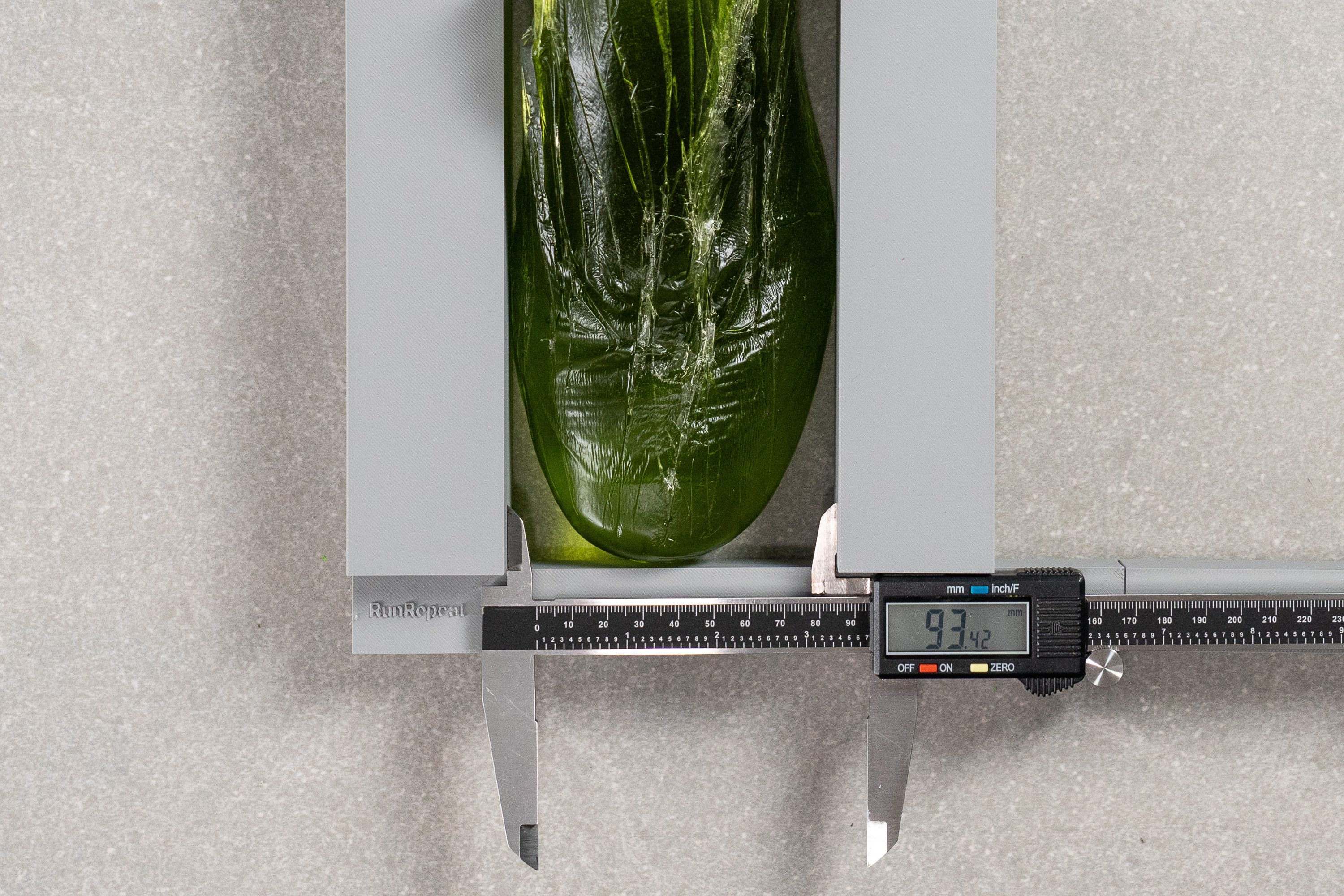
| Outpulse | 93.4 mm |
| Average | 94.1 mm |
Toebox width
We found the toebox tapering to be pretty moderate in the Salomon Outpulse. Our caliper showed a standard width measurement in the big toe area (72.0 mm) so you can expect a regular fit in this hiking shoe.
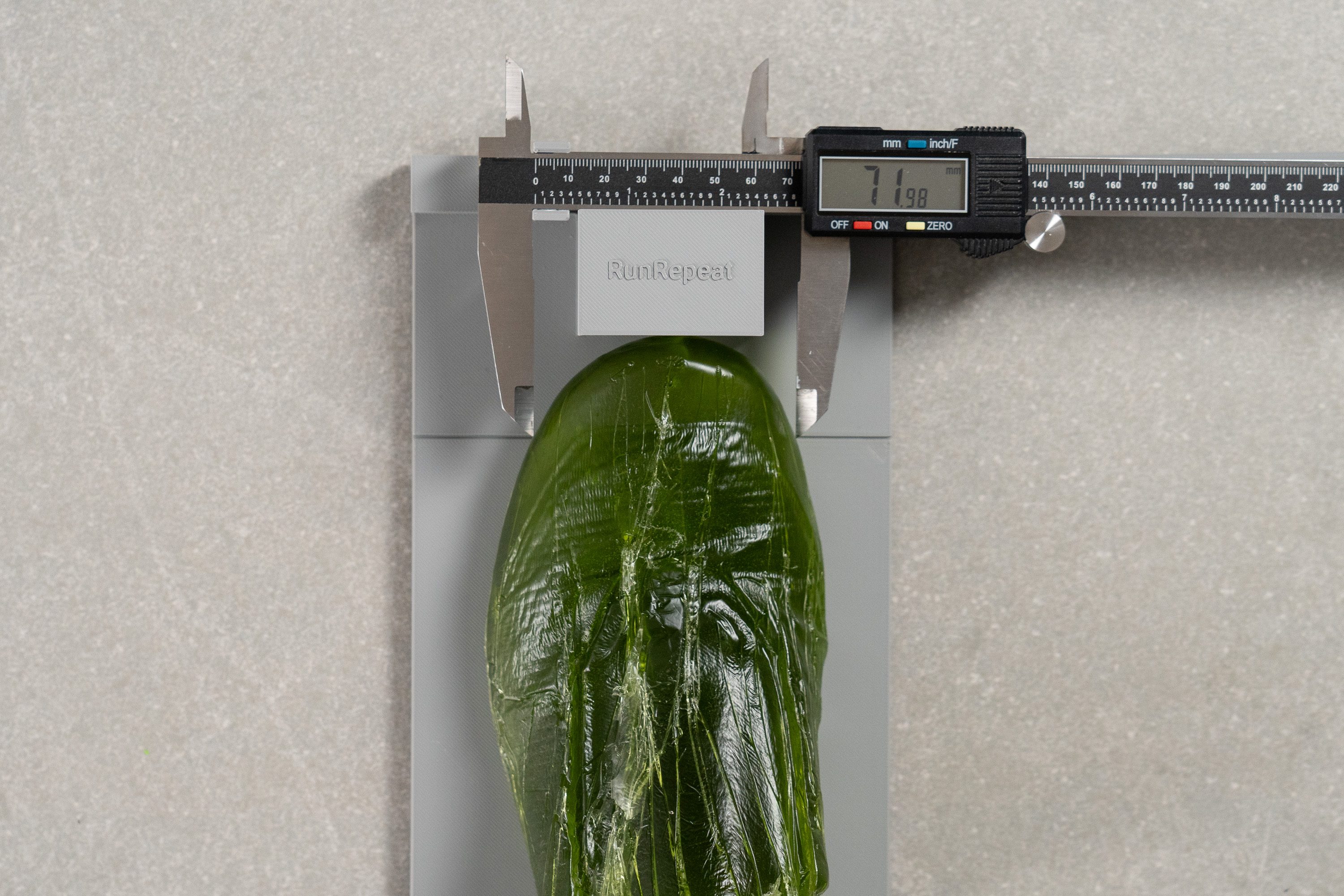
| Outpulse | 72.0 mm |
| Average | 72.5 mm |
Toebox height
However, some hikers' toes might feel constricted in the Outpulse because of the shoe's below-average toebox height of 25.1 mm. This is particularly important to note if you are struggling with black toenails, Morton's toe, or any other toe-related concern.
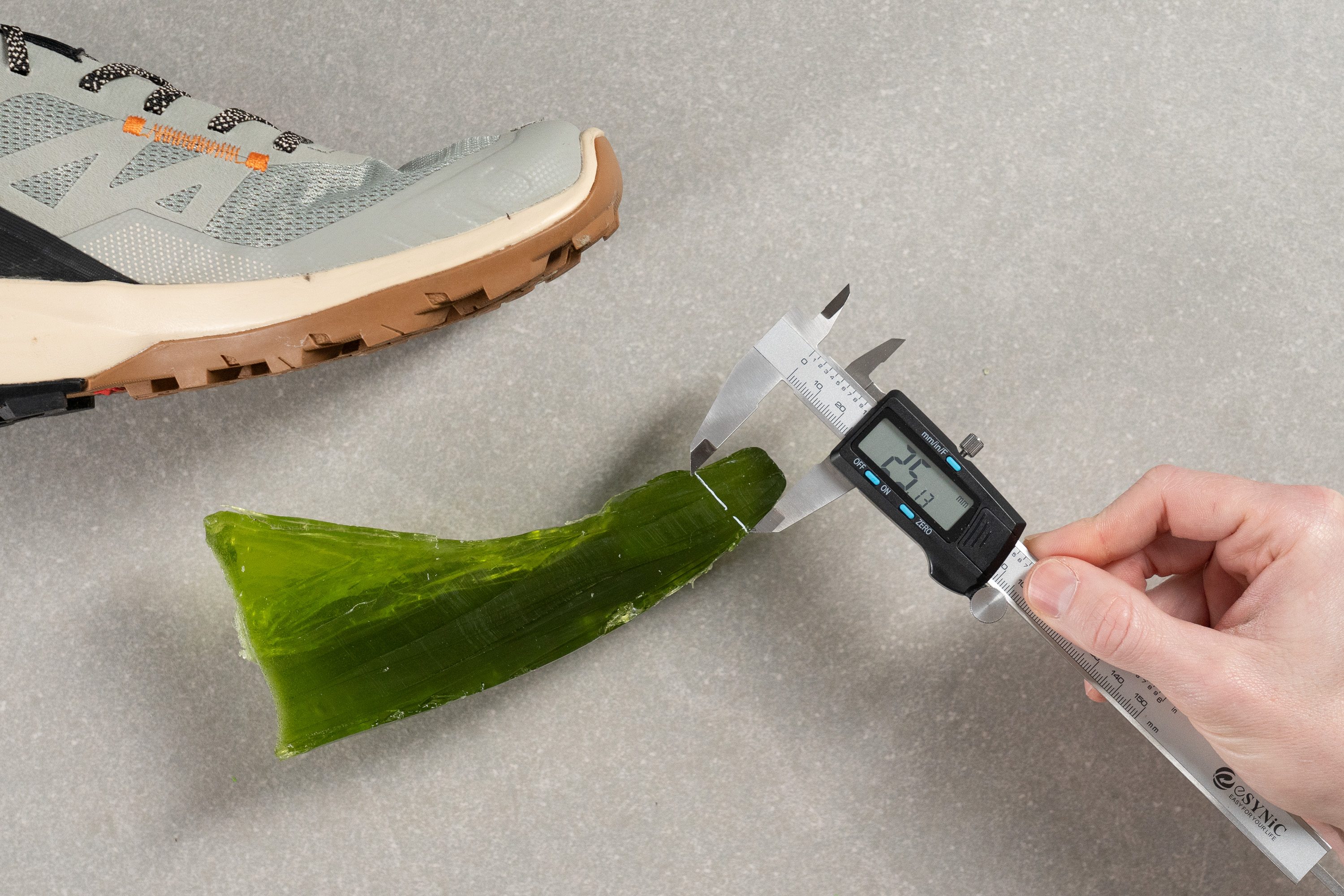
| Outpulse | 25.1 mm |
| Average | 28.0 mm |
Traction / Grip
Lug depth
The Outpulse’s lugs fall within the average range for hiking shoes at 4.1 mm according to our caliper measurements. Their distinguishing feature is their configuration; with the varied and multi-directional shapes forming a somewhat irregular pattern along the outsole ensuring that we enjoyed excellent traction over a multitude of surfaces, whether wet or dry.
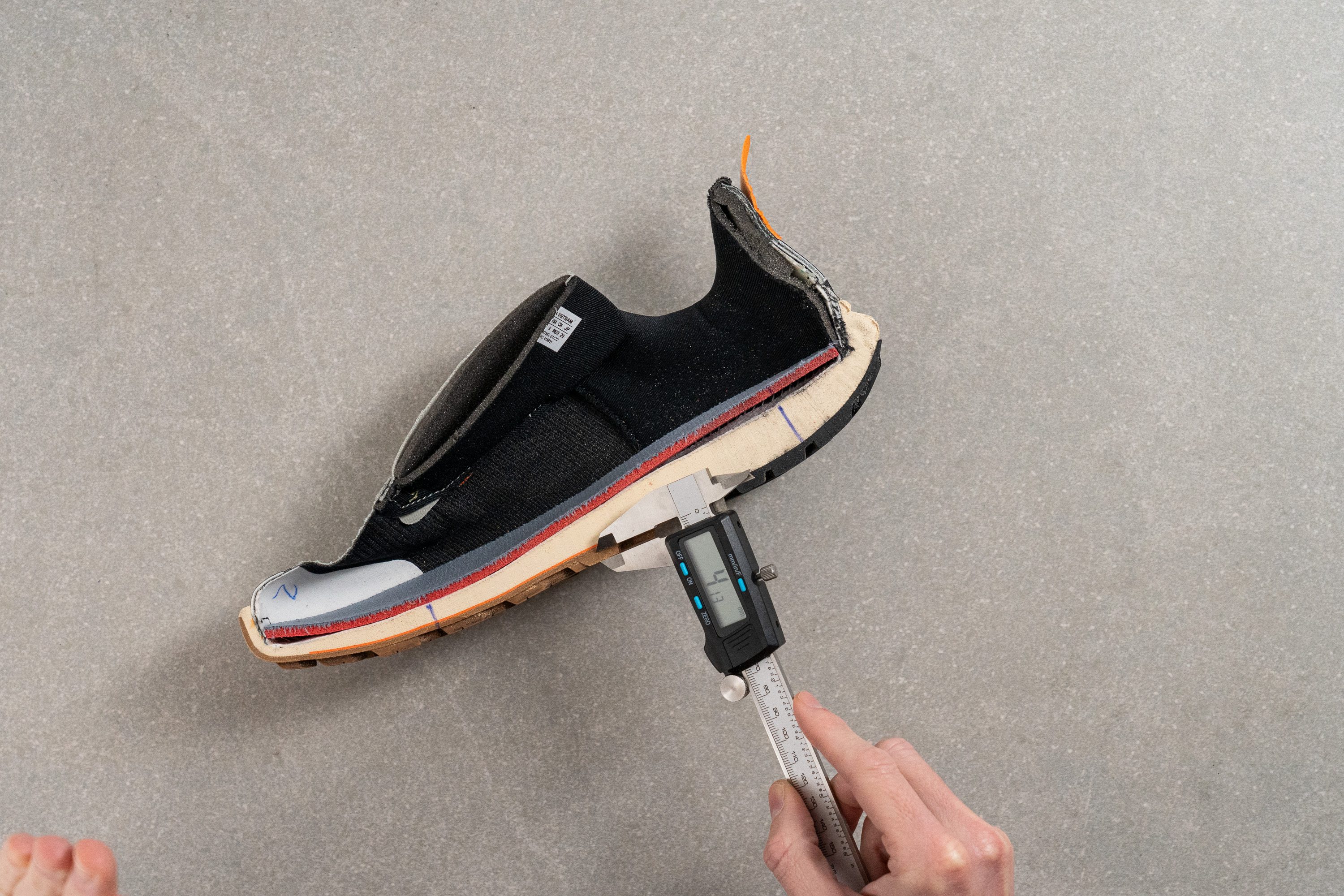
| Outpulse | 4.1 mm |
| Average | 4.0 mm |
Flexibility / Stiffness
We secured the Outpulse to our workbench and used a force gauge to measure the amount of force needed to bend the shoe 90 degrees and got a reading of 24N. This is significantly more flexible than our current lab average and means that the Outpulse is able to conform with the natural flexion of our foot with relative ease. As such, the shoe feels very comfortable and forgiving on the foot, even after long and arduous treks with frequent inclines and declines.
This test follows an older methodology, which is why you don't see recently tested shoes in the chart. Results from different methodologies can not be compared.
| Outpulse | 24.0N |
| Average | 29.6N |
Stiffness in cold
We also repeated the stiffness test after leaving the Outpulse in our freezer for twenty minutes, this time finding that 27.4N of force is now needed to bend the shoe to the desired point. This is much more flexible than the average hiking shoe under similar conditions and means that the Outpulse should feel just as easy on the foot during winter hikes.
| Outpulse | 27.4N |
| Average | 38.2N |
Stiffness in cold (%)
With only a 14.1% increase in stiffness between warm and cold conditions, the Outpulse is a remarkably consistent shoe that remains comfy and protective no matter the season.
| Outpulse | 14% |
| Average | 28% |
Weight
Weighing in at 11.6 oz (330g), the Outpulse is quite a bit lighter than the average hiking shoe. Apart from the use of lightweight materials in the shoe’s upper, the Outpulse’s lively and bouncy midsole further contributes to the shoe’s lightweight feel during our test hikes. As such, the Outpulse feels more like a trail running shoe which makes it a great choice for those who enjoy speedier hikes.
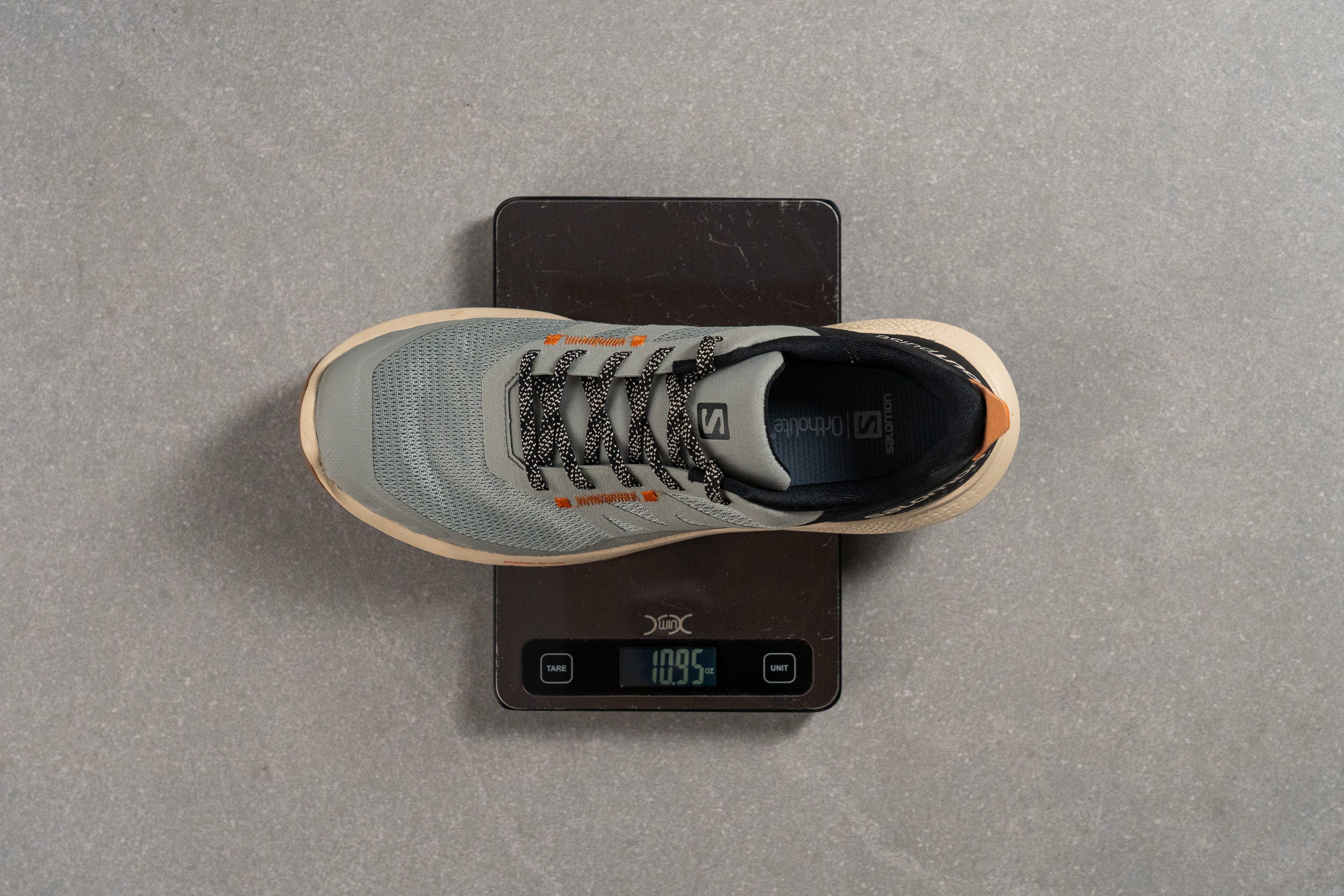
| Outpulse | 11.6 oz (329g) |
| Average | 13.4 oz (380g) |
Breathability
To test the airflow of the Outpulse, we subjected it to our state-of-the-art smoke test. As we can clearly see from the video, the whole shoe releases plumes of smoke almost immediately and continues to do so throughout the twenty-second test. This stellar performance earns the Outpulse a perfect 5 out of 5 for breathability.
However, inspecting a backlit cross-section of the shoe’s upper left us somewhat perplexed as the material doesn’t allow any light to shine through. This usually indicates a poorly ventilated shoe.
Turning to our microscope for answers, we can see that the upper is made up of two layers of mesh. The outer layer is made up of a grid of interwoven braids that open up to form a pattern of regularly spaced perforations. These gaps reveal the lower layer of a more densely woven grey mesh with lots of micro-gaps that encourage airflow through the shoe.


| Outpulse | 5 |
| Average | 2.4 |
Stability
Lateral stability test
The Outpulse does have a bit of a lateral roll when shifting our weight from side to side in the shoe. While this shouldn’t be a problem on average day hikes, we don’t recommend using this shoe for backpacking as it's not stable enough for carrying heavy loads over uneven terrain.
The Merrel Moab 3 is a more sure-footed alternative that we recommend when busting out the overnight packs for those extended multi-day hikes.
Torsional rigidity
We faced an average amount of resistance when we attempted to bend and twist the shoe in our hands, leading us to give the Outpulse a 3 out of 5 for torsional rigidity. This level of rigidity allows the shoe to twist along with our foot to a certain extent over irregular surfaces while also providing a good amount of support.
| Outpulse | 3 |
| Average | 3.7 |
Heel counter stiffness
Squeezing and prodding the Outpulse’s heel counter reveals that it is also moderately stiff, earning it a score of 3 out of 5. This is neither too stiff nor too flexible and comfortably holds our heel in place without putting too much pressure on our tendons.
| Outpulse | 3 |
| Average | 3.7 |
Midsole width - forefoot
We measured the Outpulse’s midsole to be 107 mm wide at the forefoot which is narrower than our current lab average. While this does contribute to the shoe’s nimble feel underfoot, this lack of a broad base explains the tippiness we felt in the lateral stability test.
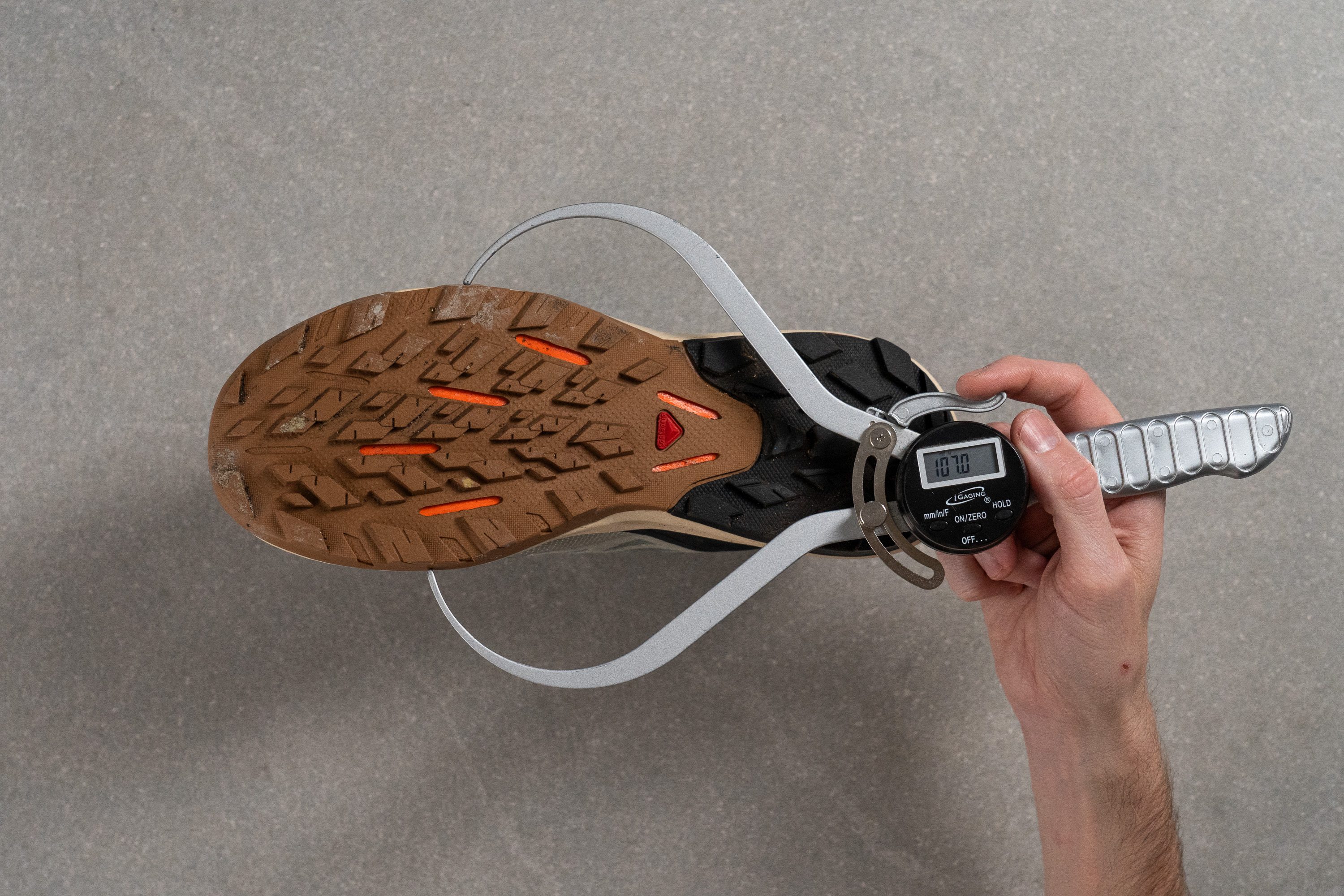
| Outpulse | 107.0 mm |
| Average | 111.3 mm |
Midsole width - heel
Conversely, the midsole is slightly wider than average at the heel; measuring 88 mm wide. This means that our landing felt very stable during our test hikes, with the wide surface area of sharp lugs really biting into the surfaces as we trudged along.
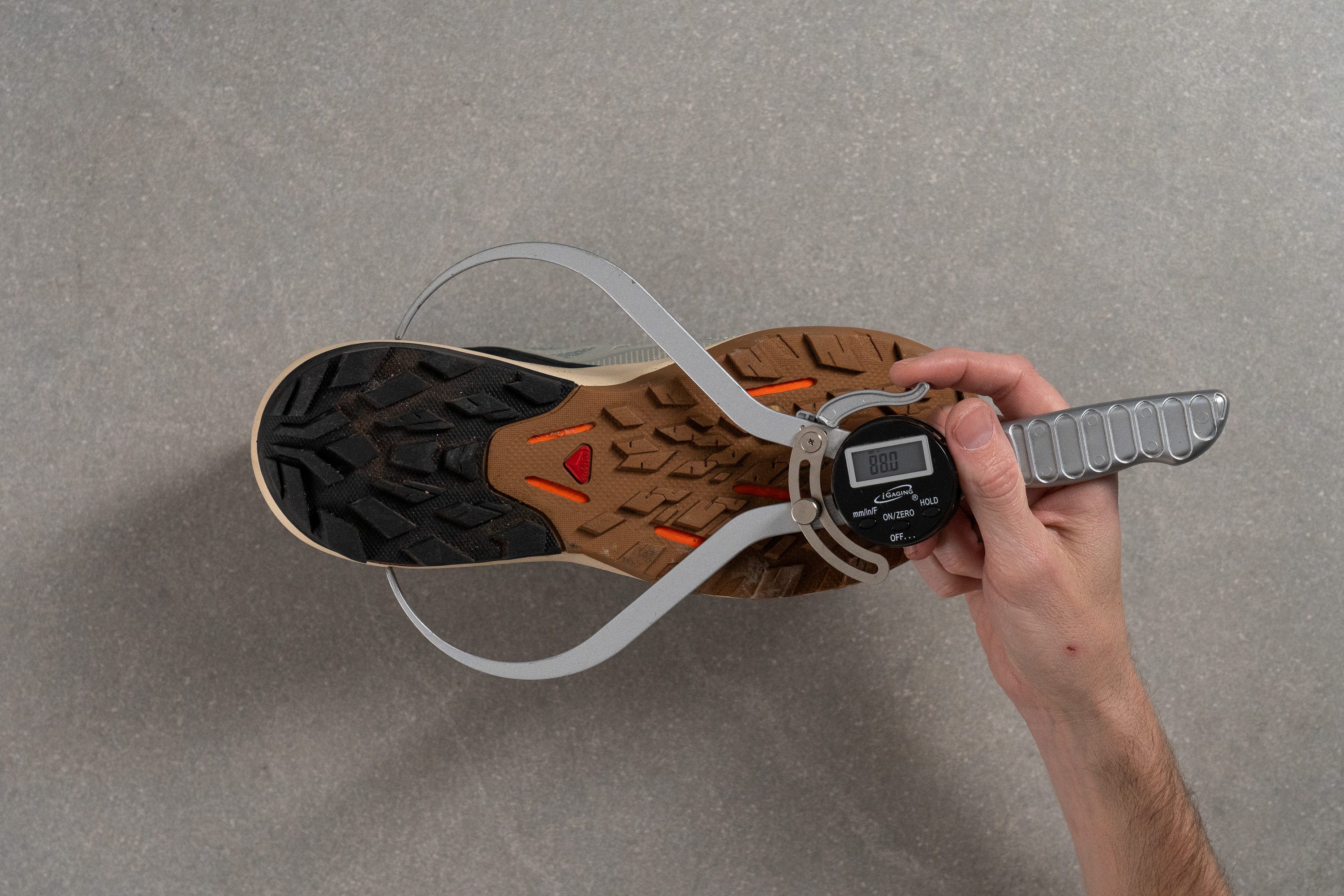
| Outpulse | 88.0 mm |
| Average | 87.9 mm |
Durability
Toebox durability
First up to face the Dremel in our battery of durability tests is the toebox. We fired up the tool to 5K RPM and applied its grinding element to the most vulnerable area of the toebox with 3.2N of force. Things don’t look good at first as our tool immediately rips into the reinforced section of the toebox.
However, we were pleasantly surprised to find that we hadn’t blasted through the toebox after the four-second test. Our grinding element only manages to leave an unsightly crater in the reinforcing material, leaving the mesh below relatively intact. This leads us to give the Outpulse a toebox durability score of 3 out of 5 which means that we shouldn’t fear accidental snags or tears when taking this shoe through untamed and bushy trails.

| Outpulse | 3 |
| Average | 3.7 |
Heel padding durability
We fired up our Dremel for a second time and took aim at the Outpulse’s heel counter. This time our tool seemed to have absolutely no effect on the shoe, with its grinding element impotently skating off the shoe’s lining material throughout the four-second test.
With the heel counter looking very much as it did before the test, we are left with no choice but to give the Outpulse a perfect 5 out of 5 for heel padding durability. This means that even after numerous grueling hikes, the shoe’s heel padding won’t be compromised and should still provide a snug and comfy rearfoot lockdown.
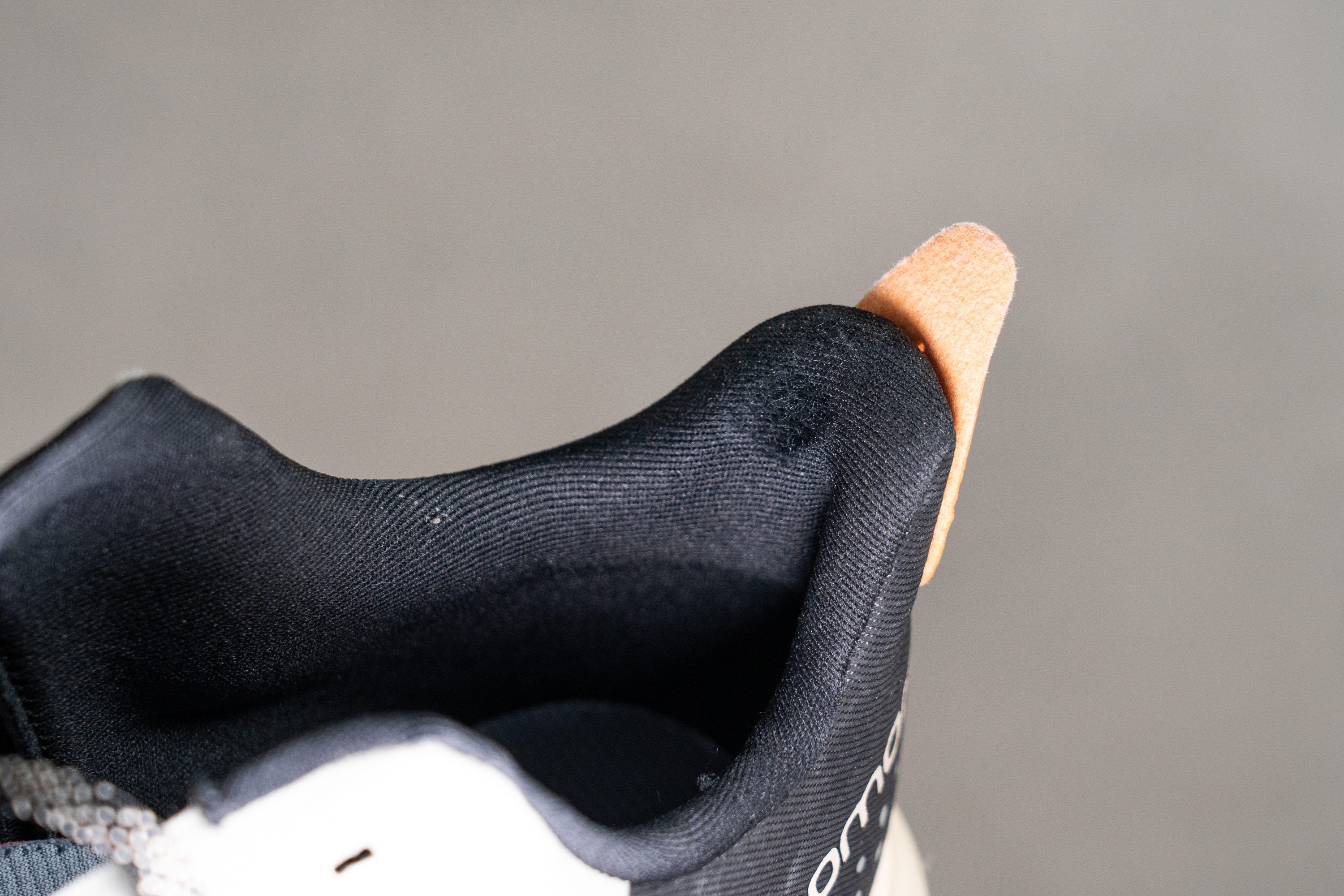
| Outpulse | 5 |
| Average | 3 |
Outsole hardness
To measure how hard the Outpulse’s outsole material is, we pressed our durometer against one of its lugs and got a reading of 85 HC. This is within the average range for hiking shoes and implies a good balance of grip and durability, the latter of which will be tested in the next section

| Outpulse | 85.0 HC |
| Average | 85.1 HC |
Outsole durability
This time spinning at 10K RPM, we applied our Dremel to one of the Outpulse’s lugs for a total of twenty seconds. After the rather uneventful test, we used a tire tread gauge to measure the indent our tool had created and found that only 0.32 mm of material had been shorn away.
This is a much better performance than the average hiking shoe, which loses almost four times the amount of material in this same test. As a result, we expect the Outpulse to last a good thousand miles before noticing any major signs of wear and tear.

| Outpulse | 0.3 mm |
| Average | 1.0 mm |
Outsole thickness
Using our caliper, we measured the outsole between the lugs and the midsole to be ever-so-slightly thicker than average at 2.8 mm. This means that we have plenty of material to wear through once the lugs are compromised, which theoretically improves the longevity of the shoe. However, with the hardiness of the rubber as demonstrated in the previous section, we think that Salomon could have skimped on some material here in order to shave some more weight off this shoe without sacrificing durability.

| Outpulse | 2.8 mm |
| Average | 2.5 mm |
Misc
Insole thickness
At 3.9 mm thick according to our caliper, the Outpulse’s insole isn’t as plush as our current lab average but still provides a soft enough surface within the shoe to feel comfortable during our test hikes.
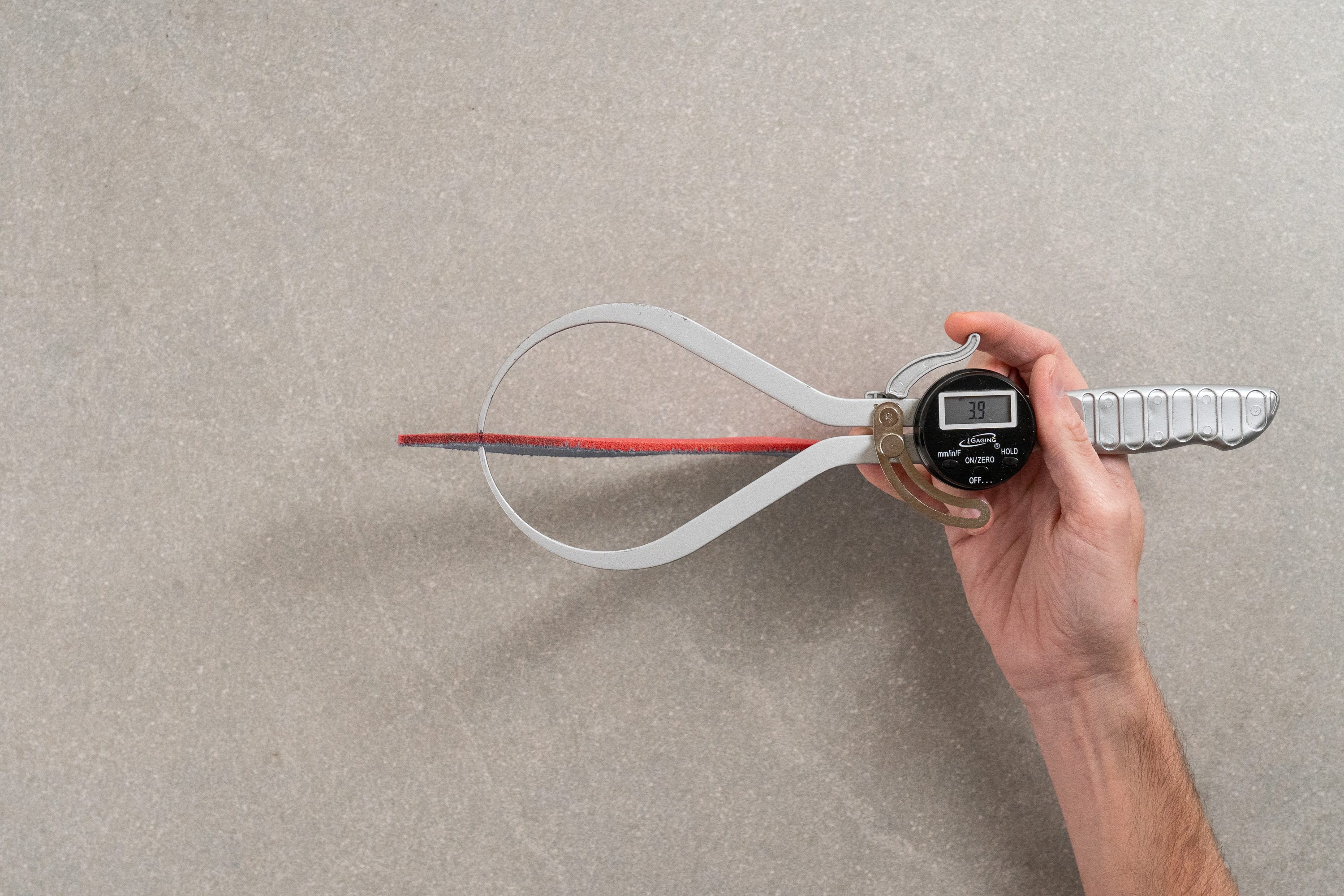
| Outpulse | 3.9 mm |
| Average | 5.3 mm |
Removable insole
The Outpulse’s insole isn’t glued in, so those in need of custom orthotics can use them with this shoe.

| Outpulse | Yes |
Midsole softness in cold
To see how the midsole foam reacts to the cold, we let the Outpulse chill in our freezer for twenty minutes. With a post-freezer durometer reading of 25.9 HA, the Outpulse’s midsole remains much softer than the average hiking shoe’s under similar conditions. This means that no matter how frigidly cold the weather gets, the Outpulse will still feel soft and forgiving underfoot.
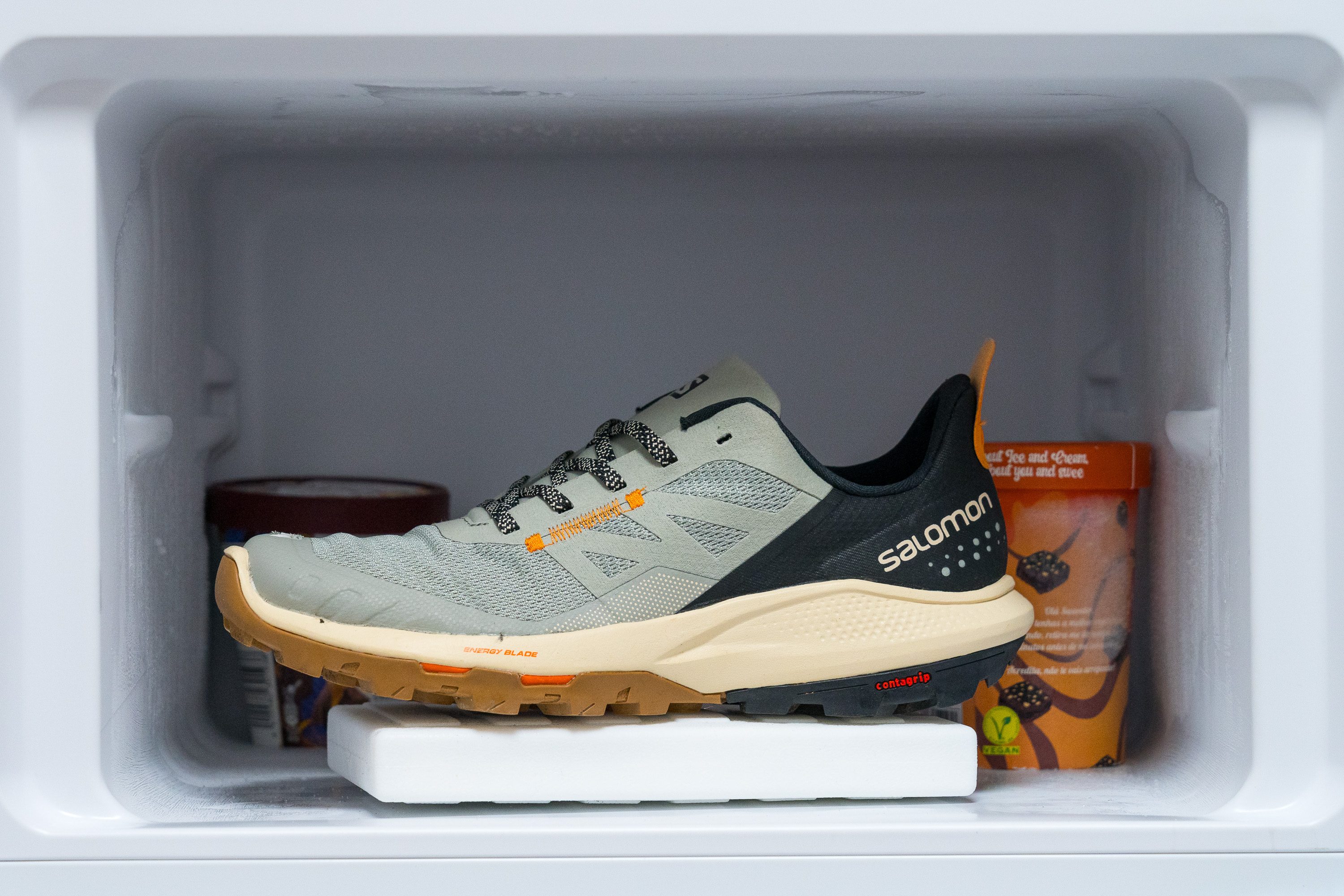
| Outpulse | 25.9 HA |
| Average | 32.1 HA |
Midsole softness in cold (%)
Becoming only 14.4% firmer in cold conditions means that the Outpulse’s midsole is much more consistent than average as the seasons change. However, the shoe’s ample airflow, as demonstrated in our smoke test, means that we do recommend pairing this shoe with a pair of thick socks to avoid frosty feet during winter hikes.
| Outpulse | 14% |
| Average | 19% |
Reflective elements
The Outpulse doesn’t feature any reflective elements whatsoever, so we recommend exercising caution and using high-vis gear if hiking along a road at night.
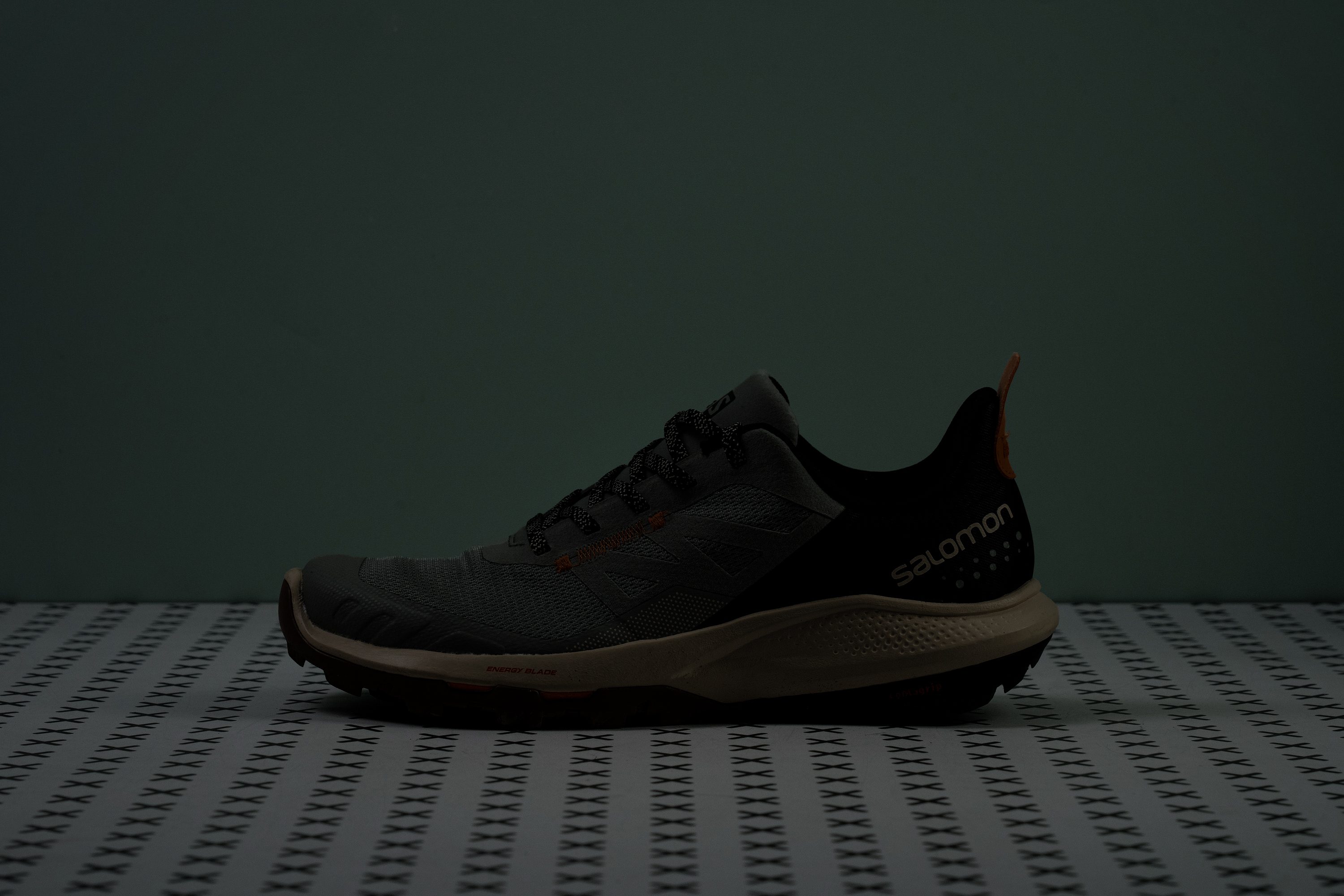
| Outpulse | No |
Tongue padding
At 6.4 mm according to our caliper, the Outpulse’s tongue is significantly less thick than the average hiking shoe’s. However, this is still enough padding to provide a comfortable and secure midfoot lockdown without any hint of lace bite.

| Outpulse | 6.4 mm |
| Average | 10.2 mm |
Tongue: gusset type
The Outpulse’s non-gusseted tongue is one of the main bugbears of this otherwise excellent shoe. We would have appreciated at least a semi-gusset to stop the tongue from slipping during our speedier hikes.
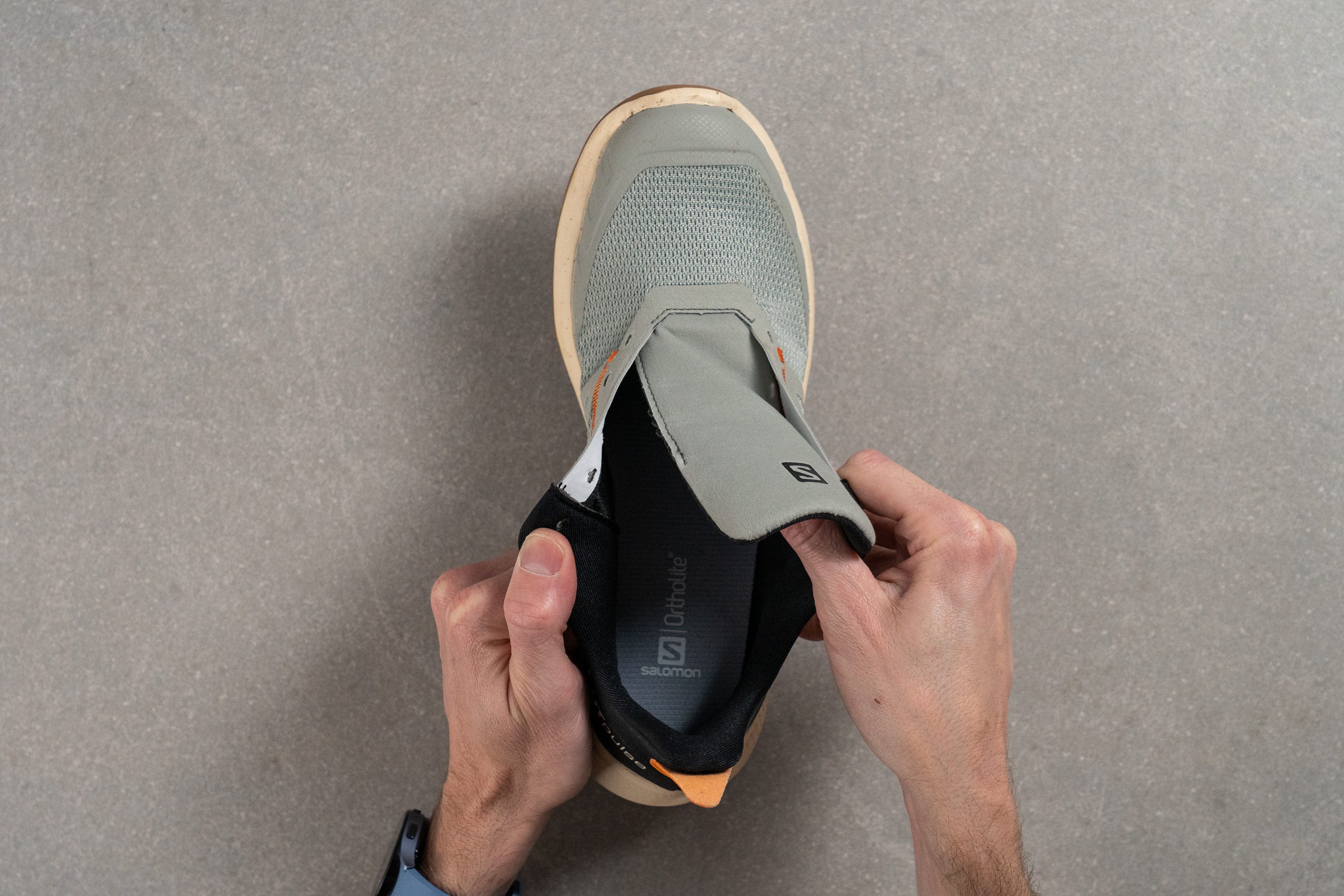
| Outpulse | None |
Heel tab
The flared heel counter features a stylish pull-tab that makes slipping the shoe on easier and looks pretty cool too!
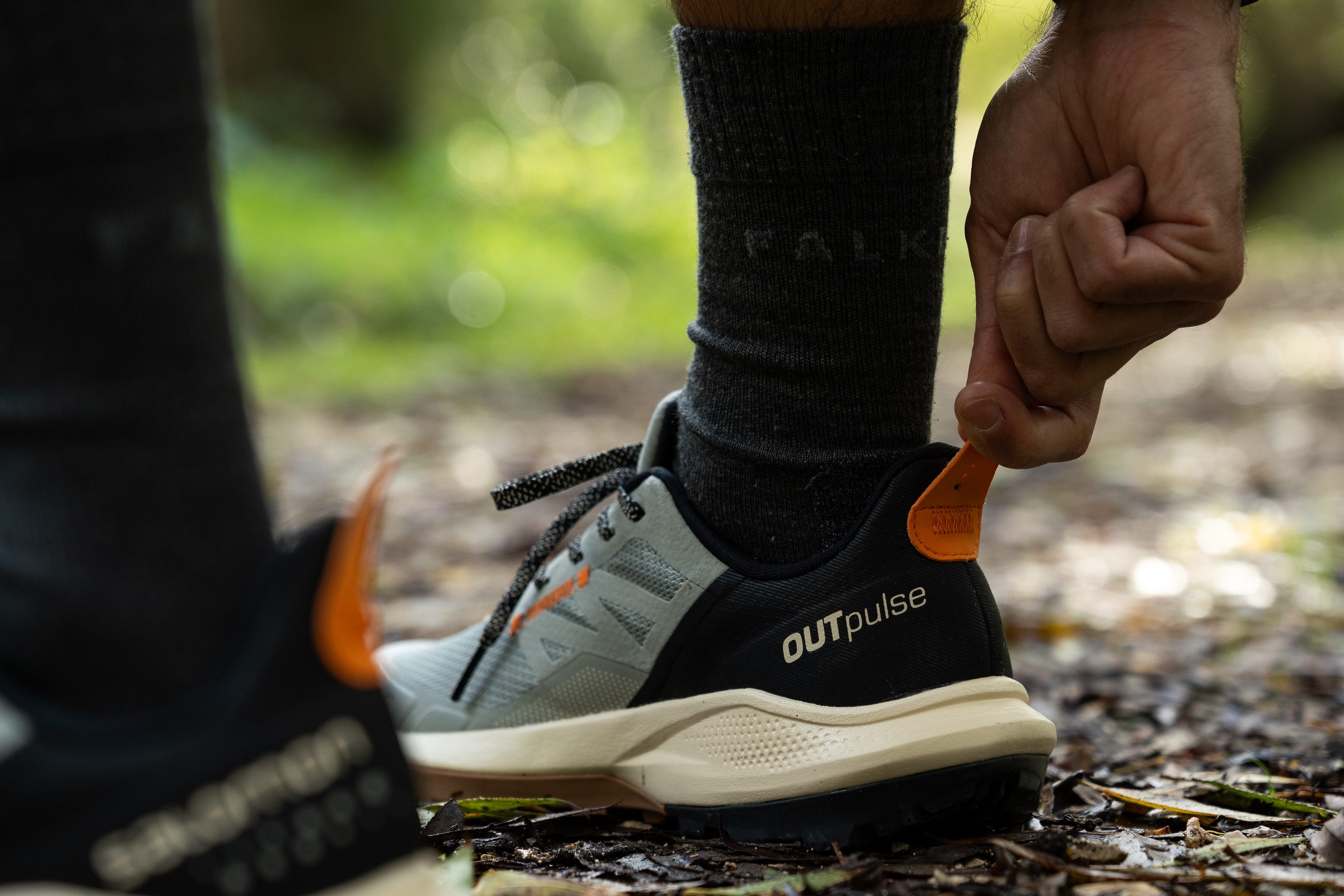
| Outpulse | Pull tab |













































